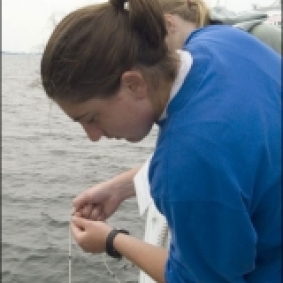Eight students will be presenting the summer work at the Ocean Sciences Meeting in March 2022!
Erin Dreis, Northern State University
Class Year:
2006Mentor:
Joel Baker, Ph.D.Project Title:
Bioaccumulation of Polybrominated Diphenyl Ether Flame Retardants and Polychlorinated Biphenyls in the Polychaete Worm Nereis virens
Abstract:
Polybrominated diphenyl ethers (PBDE) are hydrophobic molecules that are used as flame retardants. There are three commercial mixtures produced: Penta-BDE, which is the most bioaccumulative, Octa-BDE, and Deca-BDE, which is the most commonly used.
PBDEs are found everywhere. They can be found in very high concentrations in sediment. Bioaccumulation of PBDEs and PCB 209 was assessed using the polychaete worm Nereis virens. Nereis virens were exposed to spiked sediment (1000ng/g dry sediment Penta-BDE, 2600ng/g dry sediment Deca-BDE, 2500ng/g dry sediment PCB 209) for 28 days. Bioaccumulation occurred from all three contaminants, with Penta-BDE accumulating the most. Deca-BDE was found to accumulate in Nereis virens in small concentrations. This accumulation of the Deca-BDE provides a possible pathway for the contaminant to enter the food chain.





